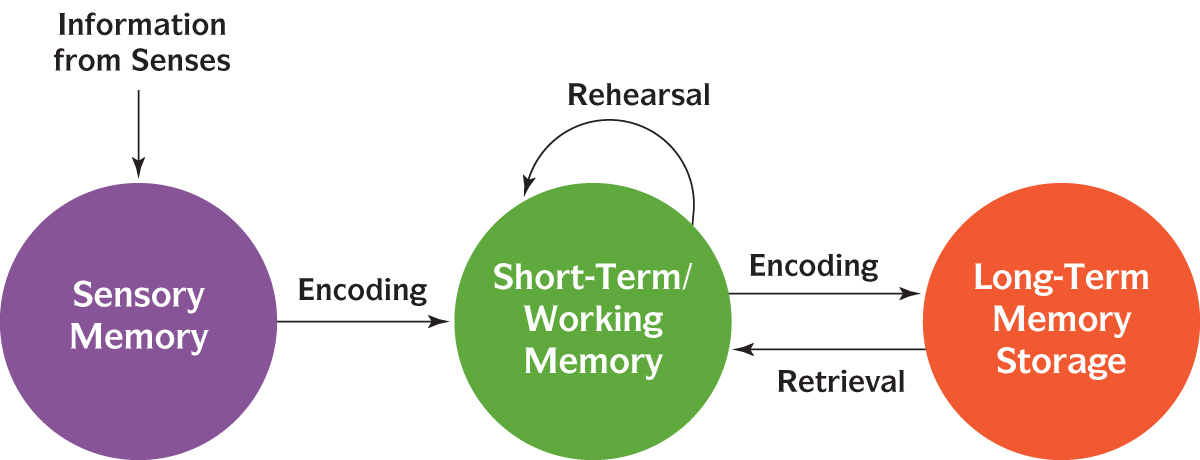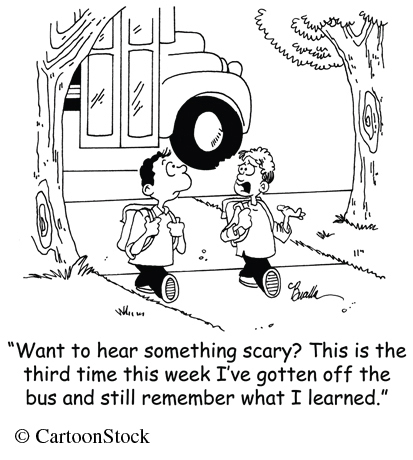Learn How Your Memory Works
Think of memory and studying as partners who walk hand in hand. After all, if you can’t remember the information you’re studying, you won’t learn it. As a result, you won’t be able to use it later to get work done for class. To understand how memory works, and why it sometimes fails, it helps to think about how your brain takes in the information coming from your textbooks and instructors — and then turns that information into memories. Memory involves three processes:
FOR DISCUSSION: As a discussion starter, show the class PBS.org’s video How Memory Works. What did students learn about memory that they didn’t know before viewing the video? What questions do they have about the concepts discussed in the video?
Encoding: Taking in information and changing it into signals in our brain.
Encoding, or taking in information and changing it into signals in our brain
Storing the information in our memory
Retrieving the information when we want to remember it
To get a basic sense of how memory works, consider what happens when you run out of milk. You open the door of the fridge, and you see a milk carton on the shelf. You pick it up and realize it’s almost empty. This information from your senses of sight and touch is encoded into your brain as an idea: You need to pick up milk on the way home. You repeat this thought several times as you head to class (“Don’t forget to buy milk”), and this repetition stores the idea in your memory. Later, on your way home, you retrieve your memory about the milk and stop at the store to pick up a carton.
ACTIVITY: Ask students to write down one thing they are experiencing right now for each of the senses of smell, hearing, sight, and touch. Then have them answer the following: How many of those things were you paying attention to before this activity? Would you have remembered any of them tomorrow? Why is it beneficial not to remember some of the things in our sensory memory? Explain.
How You Remember
Making memories is incredibly complex, and scientists have many theories about exactly what occurs and why. According to one common model, which we’ll focus on here, there are three stages of memory: sensory memory, short-term/working memory, and long-term memory.1 The processes of encoding, storage, and retrieval connect these three stages together. In the following section, we’ll look at how this relationship works — and how it helps us remember what we learn.
Sensory Memory. In the first stage, sensory memory, you take in information through your five senses and form fleeting memories based on those experiences. In college, for example, information can come in through your ears (when you listen to lectures) and your eyes (when you read textbooks). In some classes you might also use touch as you perform experiments or use equipment. A few lucky students, like those of you taking culinary classes, will also get to smell and taste in class. As you absorb information through your senses, you form sensory memories of these experiences.
Sensory Memory: Process that uses information from the senses to begin creating memories.
But sensory memories last only a split second. Our senses are constantly bombarded with information, and our brains can’t take in everything.2 It’s only when we pay attention to information that it is encoded and moves to the next stage of memory: short-term/working memory (see Figure 8.1).

Short-Term/Working Memory. Our short-term memory is quite limited in how much information it can hold and for how long it can hold it. Research shows that most people can hold about four to seven things in their short-term memory at once, and that information lasts for only twenty to thirty seconds.3 Have you met someone new, only to forget his or her name when you start chatting? Blame your short-term memory.
Short-Term Memory: Memory that stores a small number of items for a short period of time.
ACTIVITY: Divide the class into three groups. Give group 1 a list of five words and ask members to read the list once. Give group 2 a list of five words and ask members to read the list five times. Give group 3 a list of ten words and ask members to read the list five times. Collect the lists and have the class sing a short song (e.g., “Happy Birthday”). Then ask one person from each group to write on the board as many words from the group’s list as they can remember. Discuss the results with the class.
FOR DISCUSSION: Peter Doolittle’s TED Talk “How Working Memory Works” offers a great introduction to working memory. View the talk with the class as a discussion starter.
To make information “stick,” you need to put effort into remembering the information. For example, when you are first introduced to another student, you might repeat (or rehearse) his name in your head five times as soon as you hear it. In addition, you might make a mental note to ask him if he wants to be your study partner for the next exam. When you put this kind of effort into remembering someone’s name, you’re engaging your working memory — the part of your short-term memory that actively processes memories and information. Thinking about, applying, rehearsing, and connecting new information to your existing memories are all ways to use your working memory, and they help your brain encode the information and move it to the next stage: long-term memory.
Working Memory: The part of short-term memory that actively processes memories and information.
Long-Term Memory. Unlike sensory or short-term memory, the storage capacity of your long-term memory seems limitless, and memories here can last forever (although they don’t always).4 This is where you store the record of your life, such as your earliest childhood memories, your tenth birthday party, and your wedding day. Long-term memory is where you keep the facts, ideas, procedures, and skills you learn in college, such as the circumstances that led to the American Revolution and the process of cell division. It’s also the place from which you retrieve your memories when you need them — for instance, when you’re taking a history or biology quiz or when you run into a new acquaintance and greet him by name.
Long-Term Memory: Memory that stores a potentially limitless amount of information for a long period of time.
WRITING PROMPT: Ask students to recount their very first memory. How old were they? What are they able to remember? Was it just a normal day, or did something significant happen? Invite the class to explore why this particular memory stuck.
Putting It All Together. How do the three stages of memory work together? To understand this, it’s helpful to compare them to the process of creating a spreadsheet. Suppose you’re trying to save money to pay next term’s tuition, so you decide to create a spreadsheet showing how much you spent last month. You take the following steps.
First, you gather information about your income and expenses, such as paycheck stubs and credit card statements. When you see the information in front of you, you create a sensory memory of the facts and figures.
Next, you create a spreadsheet file on your computer and enter your expenses into it. The process of typing numbers is similar to your memory’s encoding process — it’s how information gets into the file. As you’re typing, you realize that you haven’t saved the spreadsheet on your computer. The unsaved spreadsheet is like your short-term/working memory: Until you make the effort to save it, you could lose the information if you had a power outage or your hard drive crashed.
Finally, you save the spreadsheet file, which is like storing information in your long-term memory. Later, you open the file and retrieve the data.
FURTHER READING: Check out the article “How to Improve Your Memory and Concentration” by Neil Burton, MD (Psychology Today, January 14, 2013). The article outlines eleven strategies to improve memory. Ask students to try one or two of these strategies over the next week. Then ask students whether the strategies were useful.
Of course, your brain is much more complex than any computer program. For example, a computer shouldn’t forget unless there’s a mechanical failure, but a human brain can forget with normal age wear and tear. Still, this analogy gives you the basic idea of how the memory processes and stages work together.
Why You Forget
We’ve seen how memory works, but what happens when it doesn’t work? Why do we forget? Forgetting occurs when there’s a breakdown in one of the memory processes. Imagine that you meet a new acquaintance named Julio, but when you run into him a week later, you can’t remember his name. What happened? There are several possibilities. If you didn’t hear his name when he first told you, then that information never made it into your sensory memory. Or you might have heard his name, but it slipped away because you didn’t pay enough attention to keep it in your working memory. This represents an encoding failure: The information got lost or wasn’t in your mind long enough to move to your long-term memory.5 The other possibility, and certainly the more frustrating one, is that you did create a long-term memory for Julio’s name but you still can’t remember it. This is a retrieval failure.6
FURTHER READING: For a brief discussion of the process of forgetting, see Edward Vogel and Trafton Drew’s article “Why Do We Forget Things?” (Scientific American, November 4, 2008).
FOR DISCUSSION: Invite two or three students to share an experience when they forgot something. It can be something important, such as their best friend’s birthday, or something mundane, such as their keys. What could have caused them to forget? An encoding failure? A retrieval failure? Discuss the possibilities as a class.
To further understand forgetting, let’s revisit the budget spreadsheet analogy. Imagine two different scenarios.
Scenario 1: When you finish working on the spreadsheet, you don’t give it a meaningful file name. Instead, you call it “Document 1.” You don’t pay attention to where you save it on your computer. And finally, you don’t open the file for nine months. When you finally want to look at the spreadsheet, you’ll probably have a hard time finding it.
Scenario 2: This time, you look closely at the computer screen as you name the file “Monthly Budget.” You save the file in your “Finances” folder. Then you access the file weekly for nine months, adding new expense and cost data at the end of each week. You’ll probably find it much easier to locate, open, and use the file in this scenario than in scenario 1. Why? Because you paid attention when you named the file, you saved it in an accessible folder, and you worked with it repeatedly. By doing this, you used all the memory processes. You took in the information using your senses, and you worked with and retrieved the information many times, which helped the memory stick.
When you learn material for your classes, the ability to encode, store, and retrieve information is crucial. Think about it this way: Scenario 1 is similar to reading a textbook chapter only once and then trying to remember information from the chapter while you’re taking a test a few weeks later. If you don’t put effort into studying the chapter, you won’t create strong memories of what you read, and you’ll have trouble remembering the information when you need it. By contrast, actively thinking about the new information, making meaningful memories of the information, and repeatedly accessing the information by studying and reviewing it will move that information from your sensory memory to your short-term/working memory, and from there to your long-term memory. In this way, you’ll remember what you’ve learned, both at test time and far into the future.
